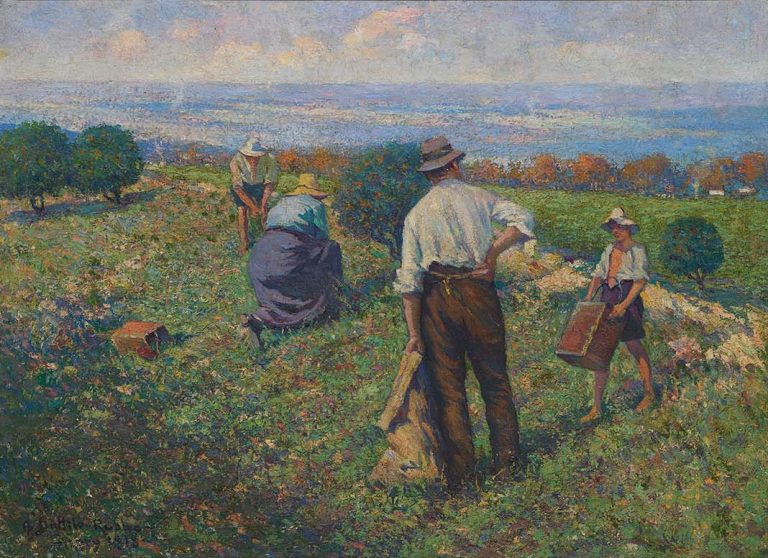We acknowledge the Traditional Owners of the land on which the Queensland Art Gallery | Gallery of Modern Art stands and recognise the creative contribution First Australians make to the art and culture of this country.
Anthony Dattilo RubboPea gathering (Kurrajong Heights) 1918
Not Currently on Display
‘As an artist, Dattilo-Rubbo is best known for his social realist portraits of Sydney’s unconventional characters.’ 1 These portraits tackled new ground, as they depicted vagrants and old people, who were not typical subjects at the time. The works strengthened the early years of his career as they were highly admired for their craftsmanship and the genre resonated strongly with the Australian public.
In 1906, Dattilo-Rubbo travelled across various cities in Europe, which ignited his passion for modern art. Pea gathering (Kurrajong Heights) exemplifies Anthony Dattilo Rubbo’s style after 1906. It depicts Kurrajong Heights, north-west of Sydney at the foothills of the Blue Mountains — an area of scenic fruit orchards that was a popular destination for country holidays.
Endnotes:
1. Art Gallery of New South Wales, ‘Anthony Dattilo-Rubbo’, <https://www.artgallery.nsw.gov.au/exhibitions/antonio-dattilo-rubbo/>, accessed August 2020.
Anthony Dattilo Rubbo was born in Naples in 1870 and received classical art training in Italy. He arrived in Australia in 1897 having been awarded the diploma of professor of drawing in public institutions by the Royal Academy of Fine Arts, Naples, and began teaching in Sydney.
In 1906 Rubbo spent seven months in Europe. He returned with reproductions of paintings by Paul Cézanne, Paul Gauguin and others whose work was little known in Australia at the time. Influenced by these artists, Rubbo enthusiastically began to teach their ideas in his lessons at the Royal Art Society of New South Wales in Sydney. His students included Grace Cossington Smith, Roland Wakelin and Roy de Maistre.
Discussion Questions
1. The artist is capturing a moment in time where people are at work. What do you notice about the way people are working? What differences may we see if this farm scene was painted today?
2. Read the title of the artwork to determine which year the painting was made. Investigate and discuss what everyday life was like in Australia at this time.
Activities
1. Imagine what items could be inside the sack the man in the painting is holding. Use words to describe the shape, colour and purpose of the item, without revealing the object’s name. See if your friend can correctly identify this item.
2. Create a mixed-media farm scene with different coloured and textured paper (old magazines are suitable), collage materials, paints, glue and a piece of paper. You may like to use a sponge with paint to texturize the sky and then define the land at the horizon point with a different colour. When dry, add detail to the background. Tear pieces of paper to create shapes and include objects of different textures to add visual interest to your picture.
